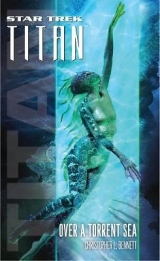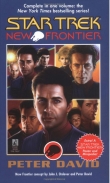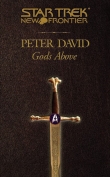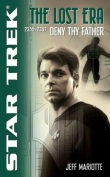
Текст книги "Over a Torrent Sea "
Автор книги: Christopher Bennett
Жанр:
Научная фантастика
сообщить о нарушении
Текущая страница: 18 (всего у книги 18 страниц)
Once Vale dove into the water and her vision cleared, the object of their journey came into view. It was a large conical structure, over four meters high. Its surface was a honeycomb lattice of hard, whitish material, the holes filled with a smooth translucent substance. It tapered to an elongated spire at the top, and four large fins were evenly spaced around its lower perimeter. It reminded Vale of the silica shell of a protistan organism she’d once seen under a microscope. Beneath the conical “shell” bulged four large spheroids, with pulsing tubes leading into them from parts unknown.
“What is it?” asked Riker. But the squales remained silent. “Lieutenant?”
It took a moment for Lavena to realize he was talking to her. “I’ll tell you if you order me, sir…but I think they want you to figure it out for yourselves.”
It was hard to tell through the scuba mask, but Vale was sure Riker was grinning. “I enjoy a challenge. Commander Pazlar?”
Melora had been glancing at the squale Lavena had named in her honor, or perhaps glaring. She had initially been flattered to learn that Lavena had named a pod leader after her, until Lavena had demurred that they had little in common beyond profession—with Melo being much more good-natured. Now, the Elaysian refocused on her work, bringing her wrist tricorder to bear. “The shell is of a dense organic polymer of some kind.”
“The clear parts of the shell seem to be a polymer resin,” Ra-Havreii added a few moments later.
“The interior appears to be filled with the same oxygenated fluid used in the lifepods,” Melora reported.
Riker swam up and gazed through the translucent ports. “It’s hollow, all right. No sign of internal organs—maybe in the lower part. And there seems to be…algae growing on the inner surface.” He played his helmet light over it. “It’s green…. Photosynthetic?”
“Yes,” Pazlar confirmed.
“The creature has an interesting nervous system,” Ra-Havreii reported. “The wattage is surprisingly high. You could power a light panel with it, which is more than you can say for the humanoid brain.”
Vale swam to the upper portion, which bulged out slightly before tapering to the spire. The honeycomb cells were smaller here, and she realized they spiraled down, growing larger as they went, as in many natural shell formations. But there was a discontinuity in the shell pattern. “There’s some sort of valve here—several plates of that dense polymer that seem to open outward. Maybe ‘hatch’ is a better word.”
Melora’s eyes were wide under her scuba mask. “Are you thinking what I’m thinking?”
“Don’t tempt me,” Vale answered.
“What do you mean?” Ra-Havreii asked.
“Melora,” Vale went on, “what can you tell about the pods at the bottom?”
The science officer swam down to scan them. “They’re made of a more flexible biological material, but they’re still very thick-skinned. I think…yes…they seem to be designed to contain fluids under very high pressure, complete with interior baffles. These conduits seem to be for filling the tanks…. Must use peristalsis to build up pressure.” She looked to Lavena. “Do we have to guess what they’re for, or will you tell us that?”
“Well, once they’re fully grown,” Aili said after a brief exchange with the squales, “two will be filled with oxygen and the other two with hydrogen.”
“My god,” Vale whispered, gazing at the conical shape of the object.
“What is it?” asked Ra-Havreii, still not seeing it.
Vale’s response was preempted by Riker’s awed laughter. “This is fantastic!”
“Will someone tell me what it is?”
Still laughing, Riker crowed, “It’s a baby space capsule!”
For millennia, Anidel sang to the offworlders, the squales had been exploring their world, seeking to quench their bottomless thirst for knowledge. Using living probes adapted from existing life forms, they had explored the depths of their native sea and the seemingly endless reaches of the sky.
But then they had found the sky was not endless after all. Over centuries, they had evolved their aerial probes to rise higher and higher, to survive ever greater cold and ever thinner air. They gained an understanding of the vast, frigid emptiness between bodies in space, but this did not terrify them any more than the emptiness of the air in comparison to the water. After all, their own World Between was as good as vacuum to the creatures of the World Below, the dynamo layer. That was a realm even the squales had not developed the means to reach, for it was impossible for their biotechnology to function there. The void of space seemed far more attainable in comparison.
And so they had studied and learned for centuries. They had derived the laws of gravity by watching the motions of the planets. They had studied the stars, learning much from them about the nature of light. Ultimately they had become aware of the invisible forms of light and developed instruments to study them. A living nervous system was a ready-made radio antenna.
Thousands of years ago, before humans or even Vulcans had ventured into space, the squales had sent forth the first capsule like this. But outside Droplet’s magnetic field, away from the Song of Life, the squales had been disoriented and impaired. The unfamiliar field of the system’s star and the emissions of the exotic elements in the debris disk had caused them discomfort. They had decided they could learn enough about the emptiness through astronomical observation, and had turned their attention back to exploring the profundities of their ocean and improving their biotechnology.
But now, Melo said, the arrival of visitors from space had inspired his pod and others in related disciplines to revive their ancient space program, recreating the design from their extraordinary racial memory. As an echolocating species, they perceived three-dimensional shapes in terms of sound patterns, and could literally speak the form of an object in detail. And they had an eidetic recall for sound patterns, keeping the “blueprints” alive in oral memory. Anidel’s team had needed to fill in certain details degraded over time, but it hadn’t proven too difficult to deduce what was needed.
The key difference, Anidel sang, came from a study of Titan’s field-neutralizing probes. Their design had given the squales some ideas for how to use the capsule’s nervous system to generate a field that would compensate for the effects of extra-Dropletian travel on squale neurology. They had wasted no time incorporating these insights into the design of this capsule, which would be over ten meters high when fully grown in a week or so. “Our thanks to you,”Anidel sang, “for giving us the final key we need to bring this ancient dream again to life.”
Once they surfaced again, it was some time before Vale could speak. “I owe you an apology, Aili. And them. This is…Tell Anidel I am truly humbled. I think maybe we’re the ones who have the most to learn here.”
“She understands,” Aili told her. “They pick up languages very fast.”
“Okay, okay. Don’t rub it in.”
Riker chuckled. “To be fair, it’s only the equivalent of a Mercury capsule,” he said. “They’re a long way from warp drive.”
“Technologically. Not conceptually. Hell, Will, we’ve seen living creatures with warp capability. If it hadn’t been for their dependence on the Song, they might’ve been the ones visiting our planet, a few thousand years ago.”
“Isn’t that a reason to leave them alone, then?” Riker asked. “Let them develop their own technology in their own direction, instead of using ours?”
Vale glared. “I hate it when you play devil’s advocate.” Taking a slow breath, she went on. “Of course that’s what we should do. Hell, something tells me they wouldn’t tolerate anything else. But that doesn’t mean we can’t… keep them in the loop. We could recommend that the Federation open diplomatic relations. Just the occasional visit. With slipstream drive, that should be more feasible in a few years. And not just for the squales’ benefit. We could learn a lot from them about biotechnology, medicine…”
“Hmm, something tells me they wouldn’t take too well to the Federation’s policy against genetic engineering.”
“It never hurts to have a contrasting opinion. And like the Denobulans and Choblik, they seem to have adjusted to their enhancements pretty well.”
Riker studied her. “You’ve really come around, haven’t you?”
“Well, I didn’t have the chance for as much close contact with them as you did. They are an impressive bunch of people.” She lowered her head. “Especially for not blaming us for what happened.”
“Hey. Don’t blame yourself, Christine. You made a mistake, but you went above and beyond to fix it. The squales see that, and so do I.” He clapped her shoulder. “You did a fine job, Commander.”
“Thank you, sir.” She frowned. “Although wouldn’t ‘below and beyond’ be more accurate here…?”
EPILOGUE
HVOV MEMORIAL HOSPITAL, PLANET LUMBU
Nurse Mawson was glad to see things getting back to normal at the hospital. Not only was Administrator Ruddle due back from her rest cure soon, but the city was growing calmer with the war fears dying down. The Cafmor had done a fine job in the last round of debates, restating her position in the finest, most elegant traditional forms and thereby undermining the Kumpen challenge to her victory. Many Kumpen were crying foul, insisting that she had been coached, but the Cafmor had proven a subtler point: by making the same argument in traditional rhetorical structure that she had in more informal words, she had implicitly demonstrated that the form was irrelevant, undermining the Regent’s position enough that a majority of voters in both countries had declared the Cafmor victorious. So Lirht was safe now, and so was Kump, for what would the Lirhten want with that arid, mountainous waste anyway? All they had there were dilithium crystals, and what good were those?
And then there was the other thing. But Mawson and her fellow maternity nurses had little to say about that. And those who’d chosen to speak of it had soon learned there was little gain in doing so, for the government, the press, and the public were satisfied to chalk it up to mass hysteria, the people’s fear of a looming war manifesting in visions of spirits and monsters. Mawson and her nurses knew better, but they were content to communicate it in knowing looks and shared laughter. In years to come, they might get together and speak of it in reminiscence, maybe privately debate the true origin of the giant men and women and the scaled monster with the hands of a surgeon. For now, they were content to absorb the experience in their own thoughts. For Mawson, it had reaffirmed a faith she had begun to question in these uncertain times, this age of electricity and factories and motor carriages, when nature and the spirit world seemed more distant than they had in her childhood. Now she had confirmation that the spirits were there, and that they had children and loved and protected them just as people did. That reassured her, inspired her to put more passion into her work. But she also knew that the spirits had their own lives to lead, that people could not rely on them to interfere in mortal affairs—that it was up to people themselves to find their own solutions to their wars and plagues and so forth. That the only guidance the spirits could offer was by example. But these spirits had proven to set a fine example—after a rocky start, to be sure, but imminent childbirth tended to do that to people.
As Mawson left the hospital for the night, she looked up at the stars and wondered if the giant baby and her mother were happy.
DROPLET, STARDATE 58590.2
The capsule ascended on a pillar of wind.
Borne aloft on a thermal by huge, transparent balloons—related to the weather-balloon creatures and bred specifically for this purpose—the fairy-castle rocketship rose toward the tenuous reaches of the sky. When it had risen as far as it could go, a spark from its supercharged nervous system would fire its rockets, sending it…
Well, not far,Will Riker thought as he watched its ascent. The squales were nowhere near far enough along to get into orbit, since it had been less than two weeks since they’d begun the project, even if their ability to build on ancient knowledge accelerated the program considerably. This was merely a propulsion test, but it was a historic enough event that Riker had accepted the squales’ invitation to remain at Droplet until after the launch.
“Lovely weather for it,” Deanna said, and he lowered his eyes from the diminishing speck of the capsule to gaze upon her. She lounged beside him on a floater-islet beach, while Natasha Miana Riker-Troi nursed at her breast.
He smiled. “Beautiful scenery indeed.”
“Oh, you.”
“I just wish it could last.” He stroked Tasha’s head, but she remained focused on slaking her appetite. “We came so close to losing each other.”
“We have before,” Deanna told him. “And we will again. But we have a good crew, and I have faith that they’ll always bring us back together. Back to this…the three of us.”
“Sir?” It was Lavena, swimming up into the shallows. Two squales were behind her; Riker couldn’t tell them apart, but he suspected they were her young friends. “They’re ready.”
“I think it would be diplomatic,” Deanna said, “if we joined them in the water for the occasion. After all, they’re extending their first toe into a new sea.”
“But the view is better here.”
“A few meters won’t make any difference to the view. Besides, it’s even more humid here than it was in the holodeck. I’m dying for a swim,” she said, meaning it this time.
Shrugging, he acceded to her wishes. They stayed in the shallows, with Deanna keeping the baby close but letting the water bear much of her weight. But they knew Tasha would be safe so long as the squales surrounded them. Indeed, the squales seemed intrigued by the child, coming up close, extending their tentacles to touch her with great delicacy, and flashing color patterns that Riker imagined were the squale equivalent of doting baby talk.
But soon the big event came. Riker could see little more than a sustained point of light and a distant streak of white vapor, but that was enough to tell him the test was successful. Eventually, the remote roar of the rocket reached his ears. He knew that Titanwas monitoring the event with full sensors, that Vale and the others on the bridge were seeing it in rich detail, preserving the image for history. Riker would enjoy reviewing that in time. But there was a greater wonder in being here with the squales themselves, experiencing this first step as they did, without any machines—any unliving machines—in the way.
As the distant roar faded, Riker turned back to his own first step into new seas. Tasha was splashing around, making little cooing noises that sounded like enjoyment. He met Deanna’s eyes, and she sensed his impression and nodded. “She likes the water,” she confirmed. “She’s curious about the new environment. Yes, that’s my girl, isn’t it? My daring little girl, all ready for adventure!”
“Just like her namesake,” Riker said.
“Like her father,” Troi replied. “She’s going to be quite the explorer, this one.”
Yes,Riker thought as he saw the tiny child testing her abilities, stretching her arms feebly toward the flickering squales as though eager to quest into the unknown. This one will go boldly.
APPENDIX
Who’s who on the U.S.S. Titanin Over a Torrent Sea
Captain William T. Riker
(human male) commanding officer
Commander Christine Vale
(human female) executive officer
Commander Tuvok
(Vulcan male) second officer/tactical officer
Commander Deanna Troi
(Betazoid-human female) diplomatic officer/senior counselor
Commander Xin Ra-Havreii
(Efrosian male) chief engineer
Lieutenant Commander Shenti Yisec Eres Ree
(Pahkwa-thanh male) chief medical officer
Lieutenant Commander Ranul Keru
(unjoined Trill male) chief of security
Lieutenant Commander Melora Pazlar
(Elaysian female) senior science officer
Lieutenant Commander Tamen Gibruch
(Chandir male) gamma shift bridge commander
Lieutenant Commander Onnta
(Balosneean male) assistant chief medical officer
Lieutenant Alyssa Ogawa
(human female) head nurse
Lieutenant Eviku Ndashelef
(Arkenite male) xenobiologist
Lieutenant Kekil
(Chelon male) xenobiologist
Lieutenant Chamish
(Kazarite male) ecologist
Lieutenant Se’al Cethente Qas
(Syrath asexual) astrophysicist
Lieutenant Huilan Sen’kara
(S’ti’ach male) assistant counselor
Lieutenant Pava Ek’Noor sh’Aqabaa
(Andorian shen) gamma shift tactical officer
Ensign Aili Lavena
(Pacifican “Selkie” female) senior flight controller
Ensign Torvig Bu-kar-nguv
(Choblik male) engineer
Ensign Mordecai Crandall
(human male) engineer
Ensign Tasanee Panyarachun
(human female) engineer
Ensign Peya Fell
(Deltan female) relief science officer
Ensign Vennoss
(Kriosian female) stellar cartographer
Ensign Y’lira Modan
(Selenean female) cryptolinguist
Ensign Zurin Dakal
(Cardassian male) sensor analyst
Ensign Evesh
(Tellarite female) sensor technician
Ensign Olivia Bolaji
(human female) shuttle pilot
Ensign Waen
(Bolian female) shuttle pilot
Ensign Kuu’iut
(Betelgeusian male) relief tactical officer
Ensign Hriss
(Caitian female) security guard
Chief Petty Officer Bralik
(Ferengi female) geologist
Crewman Ellec Krotine
(Boslic female) security guard
T’Pel
(Vulcan female) civilian child care specialist
Noah Powell
(human male) civilian, son of Alyssa Ogawa
ACKNOWLEDGMENTS
As always, thanks go to Marco Palmieri for commissioning this novel and initiating the Titanseries. I’m indebted to those who have come before me, including Andy Mangels, Mike Martin, and Geoffrey Thorne, and to those who offered advice on the manuscript, including Kirsten Beyer, Keith R.A. DeCandido, William Leisner, and David Mack. The President Bacco quote that opens the novel is from Destiny: Lost Soulsby David Mack. President Bacco was created by Keith R.A. DeCandido, as was Admiral Masc (mentioned in “The Ceremony of Innocence Is Drowned” in Tales of the Dominion War) and the Alrond colony (from A Singular Destiny). Information on Arkenites comes from the FASA and Decipher role-playing games. Thanks to Theodore Sturgeon for inspiring Lumbuan linguistics, and to the Freefallwebcomic for inspiring Doctor Ree’s philosophy on the power of smiles.
The concept of an ocean planet as depicted herein was proposed in 2003 by Marc J. Kuchner and Alain Léger (independently), with Léger coining the name. I am indebted to their papers on the subject: Kuchner, “Volatile-Rich Earth-Mass Planets in the Habitable Zone” ( The Astrophysical Journal LettersVol. 596, 10 Oct. 2003, pp. L105–L108) and Léger et al., “A New Family of Planets? Ocean Planets” ( IcarusVol. 169 Iss. 2, June 2004, pp. 499–504), for providing the basic information I needed to create Droplet. For more detailed calculations of Droplet’s size and internal structure, I relied on Christophe Sotin et al., “Mass-radius curve for extrasolar Earth-like planets and Ocean planets” ( IcarusVol. 191 Iss. 1, 1 Nov. 2007, pp. 337–351). More details were provided by “Ocean planets…soon” on the Crowlspace.com blog, February 4, 2007. Hal Clement’s novel Noiseprovided useful information on the meteorology of a world without land masses. Martin Chaplin’s Water Structure and Sciencewebpage at www. lsbu.ac.uk/water/was helpful for determining the behavior of water and ice under extreme pressure. The University of Rhode Island’s Discovery of Sound in the Seapage at www.dosits.org/helped fill in details about the deep sound (or SOFAR) channel. For the effect of extreme pressure on biology, I am indebted to Anurag Sharma et al., “Microbial Activity at Gigapascal Pressures” ( Science22, Vol. 295 No. 5559, Feb. 2002, pp. 1514–1516) and Christoph Hartmann and Antonio Delgado, “Numerical Simulation of the Mechanics of a Yeast Cell under High Hydrostatic Pressure” ( Journal of BiomechanicsVol. 37 Iss. 7, July 2004, pp. 977–87). Aspects of Cethente’s biology were suggested by Jean Schneider, “A Model for a Non-chemical Form of Life: Crystalline Physiology” ( Origins of LifeVol. 8 Iss. 1, April 1977, pp. 33–38).
This book is dedicated to and informed by the memory of my cat Natasha, who passed away on June 20, 2008, at the age of 17. I’ve lived with many cats over the years, but she was very special to me, one of the greatest sources of joy in my life. She is deeply missed.
ABOUT THE AUTHOR
Christopher L. Bennett is the author of two previous works of Titanfiction, the novel Star Trek: Titan: Orion’s Houndsand the short story “Empathy” in the Star Trek: Mirror Universe: Shards and Shadowsanthology. He has also authored such critically acclaimed novels as Star Trek: Ex Machina, Star Trek: The Next Generation: The Buried Age, and Star Trek: The Next Generation: Greater Than the Sum, as well as the alternate Voyagertale Places of Exilein Myriad Universes: Infinity’s Prism. Shorter works include Star Trek: SCE #29: Aftermathand Star Trek: Mere Anarchy: The Darkness Drops Again, as well as short stories in the anniversary anthologies Constellations(original series), The Sky’s the Limit(TNG), Prophecy and Change(DS9), and Distant Shores(VGR). Beyond Star Trek, he has penned the novels X-Men: Watchers on the Wallsand Spider-Man: Drowned in Thunder, and is also developing original science fiction novel concepts. More information, original fiction, and novel annotations can be found at http://home.fuse.net/ChristopherLBennett/.








